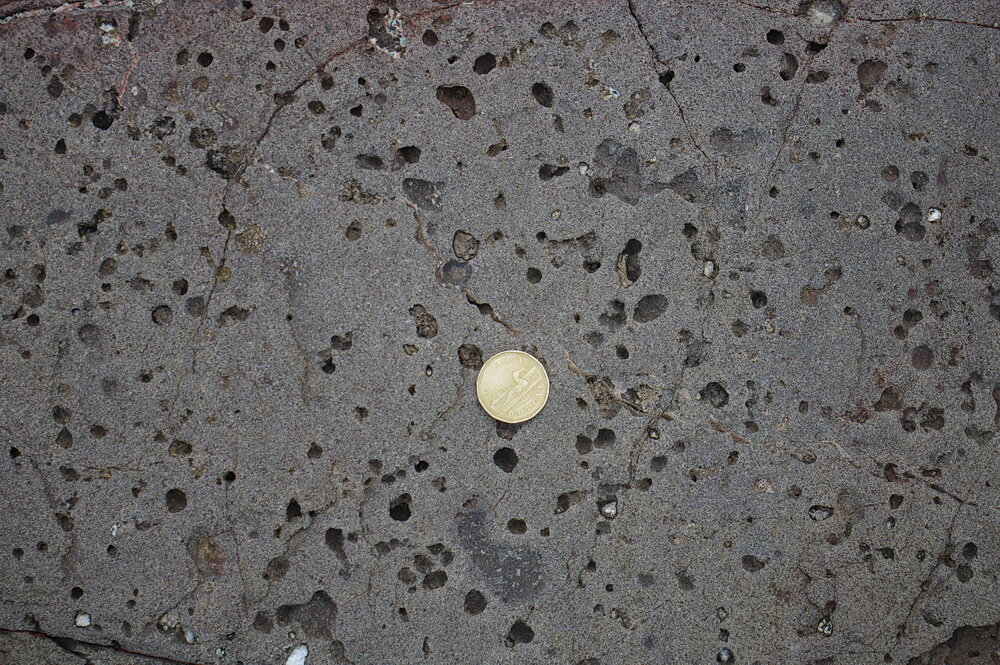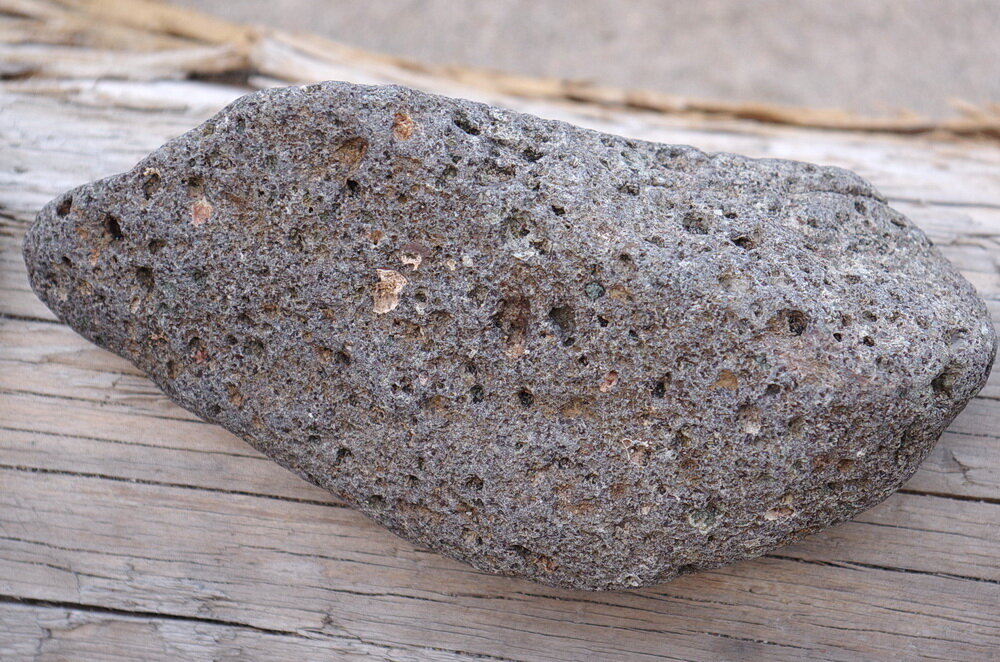Ontario: Vesicles and Amygdules
Photo 1: This photo shows part of a basalt lava, called Keweenawan basalt, that flowed over the land, along the north shore of Lake Superior, about 1 billion years ago. The magma (melted rock) contained dissolved gas that separated out to form gas cavities called vesicles. The gas cavities look like holes in the rock surface. Photo by: Andy Fyon, Deadman’s Cove, Lake Superior, Aug 21, 2018.
Gas In Melted Igneous Rock
What do a can of carbonated pop and a volcanic rock have in common? They both have gas!
Deep in the Earth, rock can melt to form magma. Cooled magma create igneous rocks. Sometimes the starting rock is made of minerals that contain a tiny bit of water, carbon dioxide or other gases. When those minerals melt to form magma, the water, carbon dioxide, or other gas from the mineral becomes dissolved in the magma. When the magma moves towards to the surface of the Earth, that dissolved gas separates from the magma, much like carbon dioxide gas separates from pop when you quickly open the top of a pop can. The gas that separates from a magma is called magmatic gas, because it separated from a magma. The gas can be called volcanic gas when it is given off by a volcano.
The liberated gas can help create a dangerous, explosive volcano or, the liberated gas can remain in the magma as tiny, trapped gas bubbles.
Vesicles
If the magma cools quickly, perhaps as a lava flow, the trapped gas bubbles become frozen as tiny cavities in the solid rock. Those tiny gas cavities in the solidified rock are called vesicles and the rock is described as being vesicular (Photo 1 and 2).
Photo 2: This Keweenawan basalt cobble, found on the beach, contains many small cavities, or holes, that are called vesicles. The cavities were once filled with gas that were became trapped when the liquid rock, called magma, cooled and became a solid rock. An individual cavity is called a vesicle. When a volcanic basalt rock, like this one, contains many vesicles, it is said to have a vesicular texture. Photo composed by Andy Fyon, Pancake Bay Provincial Park (Ontario), along the Lake Superior shore, August 12, 2018.
Amygdules
Because the vesicles are open cavities, they are often filled with secondary minerals that formed long after the magma cooled on the surface of the Earth. These secondary minerals and can include minerals such as calcite, quartz, epidote, or zeolite. Rarely, a metal, like pure copper, can form in the vesicle cavity. When a vesicle is filled by a secondary mineral, the vesicle is called an amygdule (Photo 3) and the volcanic rock is described as being amygdaloidal.
Photo 3: To the right of the coin is a vesicular Keweenawan basalt sample. It is called vesicular because the tiny cavities are open. To elongate basalt sample the extreme right is an amygdaloidal basalt. The original gas cavities have been filled with different secondary minerals. Therefore, the former gas cavities are now called an an amygdules and the sample has an amygdaloidal texture. Photo by Andy Fyon, Pancake Bay Provincial Park (Ontario), August 13, 2018.
Geological Relevance
The presence of vesicles or amygdules give geologists insights about the amount of gas that occurred in the original magma.
Magmas that contain lots of dissolved volcanic gas can generate very explosive volcanic eruptions, which are very dangerous. Vesicular lavas on a volcano can help give a warning about future dangerous eruptions.
Lavas that flowed on the surface of the Earth, but on the bottom of a deep ocean, likely will not contain any vesicles because the water pressure kept the volcanic gas dissolved in the magma. So, the presence and size of vesicles in an igneous rock has been used to try to estimate the depth of water above an eruption.
Secondary minerals that fill original vesicles give geologists insights into the conditions under which the rock cooled and processes that affected the rock over geological time. Those insights help the geologist to recreate the past history of an area.
Rock Hounding
If you are rock hounding along a cobble beach, in an area where there are old lava flows, you may see many vesicular or amygdaloidal lava rock cobbles, similar to these photos. Some many pretty display samples.
Geological Epilog
Vesicles form in igneous rock when magmatic gases separate from the melted rock to form gas bubbles. When the former gas cavities become filled with secondary minerals, the rock is said to contain amygdules. The presence of vesicles and amygdules can help geologists recreate the past history of an area, just by looking carefully at the Canada beneath our feet.
Have A Question About This Note?
Andy Fyon, July 14, 2020



